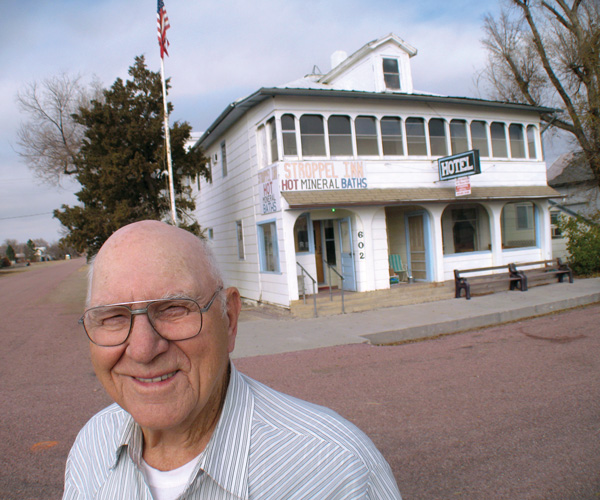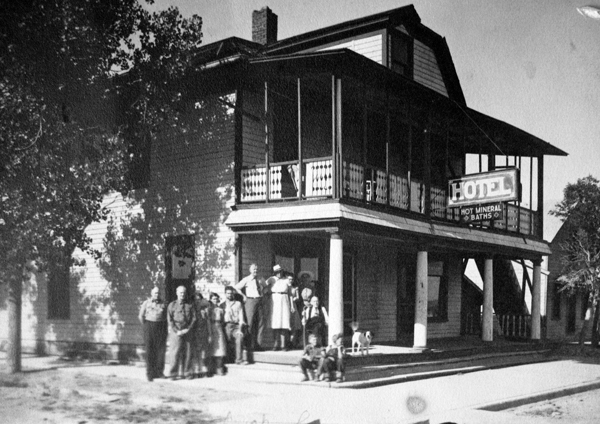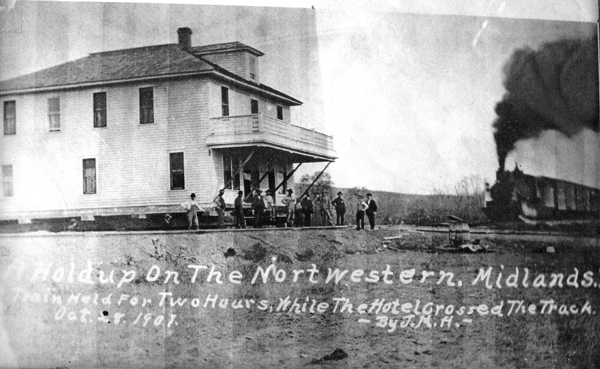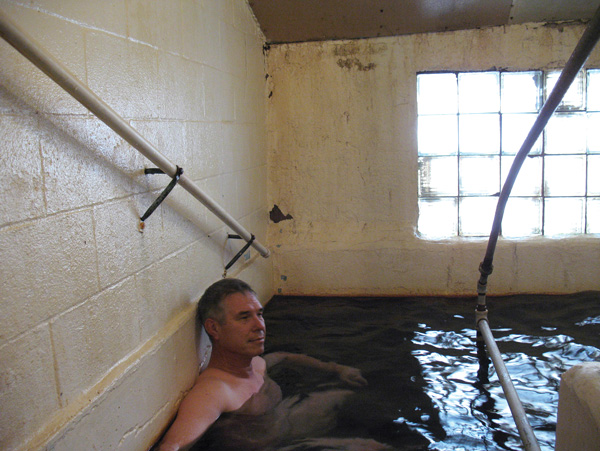The Gift of South Dakota
Subscriptions to South Dakota Magazine make great gifts!
Subscribe today — 1 year (6 issues) is just $29!
A Spa at Midland
I’ve wanted to take the plunge in Midland’s hot mineral baths since I was a kid. Every summer our family would pack the station wagon and take a road trip from Brookings to my father’s childhood home, a ranch north of Philip.
Half an hour before arriving we’d pass Midland, a dusty prairie town whose rooftops were barely visible from the eastern approach. A sign beckoned, “Downtown: HOT Mineral Baths. Stroppel Hotel.” When I asked my parents what a mineral bath was, the answers were vague, something about healthful properties. My grandpa, H.W. “Herb” Pates, once told me he went to the spa to treat his sore old rancher bones.
 |
| George Stroppel's healing hands still soothe aches and pains. |
Last fall I was planning a pheasant hunt near Pierre and thought I might need such a treatment after a day of walking fields. I searched the Stroppel Hotel online. To my delight I found it still existed, but was renamed the Lava Water Inn.
I dialed the phone number and found George Stroppel. He said he was 86 years old, but he was still a masseuse at the hotel and he remembered my grandpa. I made reservations for a mineral bath and massage.
George told me to meet him at his house next door to the hotel. He cleared the dining room table, poured me a cup of coffee and began telling me the history of the Stroppel Hotel. The story began when his father, John, moved to South Dakota from Iowa in 1907 and homesteaded 19 miles southwest of Midland. In 1914 John married a neighbor girl, Violet. They grew the ranch to 5,000 acres and had five children from 1915 to 1926.
John had a lung ailment since childhood and coughed regularly. He sought relief at a mineral bath, or plunge, in Capa, 10 miles east of Midland. A doctor operated the medicinal plunge that was fed by a well originally dug for railroad steam engines. The water’s supposed curative properties were discovered by accident. One night a local drunk, who also suffered from arthritis, passed out in a ditch full of the warm water. “They say that when he came to, he didn’t ache anymore,” George says.
 |
| In the Stroppel Hotel's early years, as many as 75 people a day sought treatment from masseuse John Stroppel. |
In 1929 John visited a hot springs mineral bath in Thermopolis, Wyo., and saw potential. He tried to purchase the spa in Capa but couldn’t close a deal, so he looked at the Bastion House in Midland.
The Bastion was built as a roadhouse during the stagecoach era in 1905. The building was moved to town in 1907 because it was too close to the new railroad tracks. In the Dirty Thirties the Bastion’s business declined and it was forfeited to Haakon County due to unpaid taxes. John bought it, hired a well digger and built three plunges. The original well descended 1,780 feet. Under natural pressure, the hot, soft water flowed to the surface at 33 gallons per minute.
In February of 1940, Stroppel began selling mineral baths. The hotel had 20 rooms that rented for 50 cents a night and 75 cents for double occupancy. People suffering a variety of ills would come for a 21-day regimen. Others came regularly for Saturday night baths. Patrons would warm up in the plunge, be wrapped in blankets and lie in a bed for 30 minutes to sweat. John hired a chiropractor to come in and give treatments. But the man drank too much, so John fired him, took a Swedish massage course and discovered a natural talent.
 |
| The Stroppel Inn halted train traffic for two hours when it was moved across the tracks in 1907. |
Up to 75 people came through daily. The Stroppel was particularly known for treating folks with excess alcohol or tobacco problems. “Dad used to say that it seemed to take the poisons out of their systems,” George says. “My idea was that the heat and dilating blood vessels let the blood through quicker.”
George’s older brother, John “Jack” Stroppel, was a World War II fighter pilot in the South Pacific. Jack came home, took chiropractic training and replaced his father, John, who retired in 1949.
George served as a gunner’s mate on the USS New Jersey and came home from World War II at age 20. He finished high school and married Alice. In 1955 he moved to Pierre to help build the Oahe Dam. In 1958, his father paid George’s tuition for a Swedish massage correspondence course from a school in Chicago. But George was busy building stock dams with a cat-and-scraper business in Philip, and didn’t immediately use the gift.
John died of a heart attack in 1959. Jack stayed until 1966, when he relocated to Rapid City with his wife. George and Alice moved from Philip with their six young children in 1969 to help Violet run the hotel.
George remembers his first, awkward massage. “Mom introduced me to three guys in the lobby,” he recalls. “They were taking baths. They said, ‘You’re Jack’s brother, you ought to be able to give massages.’ I told them no, I could hurt them. They just laughed and finally talked me into it. I felt like I mauled them around like an old bear.” When the men asked for a second massage, George had a new career.
George and Alice bought the place in 1973. George considered updating the hotel but was discouraged by the rising cost of building materials and the declining flow of the well. In 1977 he had a new well drilled. He installed a submersible pump that still runs today, bringing up 20 gallons a minute. The hotel cut back to two plunges and George used some of the water to heat the hotel.
 |
| The author begins a treatment with a soak in one of the spa's plunges. The 110-degree water has been used to treat ills from sore muscles to alcoholism. |
“People started asking, ‘Does medical insurance cover it?’” George says of the treatment costs. “When I said no, they started saying they had to go somewhere else where they could use the insurance. At that time medical doctors were the only ones that could collect insurance.”
After telling me the Stroppel’s history, George showed me the hotel. Inside its glassed-in, pillared porch is a utilitarian lobby that George says was probably fancy in 1907, but isn’t today. One wall has historic clippings and photographs on various surfaces. The business is operated from a vintage roll-top desk.
Behind it are doorways leading to the “plunges.” Each has a small dressing area, leading to another door that opens to concrete stairs descending into the water. The 8-by-8 foot tanks are four feet deep. Light streaming through glass blocks glows off white fiberglass walls. The hot water pours in from a PVC pipe above the bath surface. A standing pipe “drain” is in the concrete, taking overflow to Mitchell Creek east of town.
The treatment lasts about an hour. Step one is a soothing soak for 15 minutes. The water is about 110 degrees, depending on the weather. George tells me to immerse a shoulder that has been bothering me, and move it around. The charge for the bath is $4. Step two is a 45-minute massage. George employs the Swedish massage method, using techniques he’s honed on countless patients. The massage charge is $40.
In 1998, George and Alice sold the hotel to their oldest daughter, Patricia, and her husband, Reuben Vollmer, a local maintenance man. In 2004, the Vollmers sold it to Jill O’Neill of New Florence, Pennsylvania. The Vollmers managed it for O’Neill until 2012, when they recruited Kathy Jensen of Sioux City, Iowa, to take their place. Jensen’s family owns and runs the Bio-Chi Institute of Massage Therapy in Sioux City. She first visited the hotel in the early 2000s and was intrigued. She now operates the business as the Historic Lava Water Hotel.
George says he isn’t getting rich, but he’ll keep working as long as he’s able and as long as people get results. “Massage takes a lot out of you,” George said. “But it also gives you a lot.” He believes in the healing powers of the bath. “Think of the thousands of people who have come through and gotten help from it,” he says.
About the Author: Mikkel Pates is a Brookings native. He spent 17 years writing ag stories for The Forum of Fargo. He currently writes for the Grand Forks Herald and Agweek.
Editor’s Note: This story is revised from the May/June 2013 issue of South Dakota Magazine. To order a copy or to subscribe, call (800) 456-5117.










Comments
We stopped at the hotel and were so blessed to meet George! He showed pictures of my family and their friends. What a wonderful man! Say Hi to him and tell him thanks!
Love this for sure.
I took the hot bath (no charge) was on my way. That was 16 years ago. Never forgot it.